
|

1978 RECIPIENT
Lois Etherington Betteridge — Silversmith
About the craftsperson
|
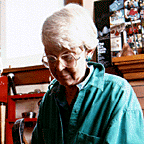
|
"The making of beautiful objects for special and important functions
signifies the celebration of ritual and the honouring of culture. This is
Lois Betteridge's stated purpose and the reason that her work speaks so
strongly to us. Whether her individual romantic pieces take organic or
geometric forms, they are essentially emotional. They deal with the
connection of our feelings to the world around us. They speak to us and
the world through their use in celebrations, whether those celebrations
are of a formal or a private nature. Lois Betteridge carefully and
thoughtfully structures every nuance of her work toward the act of use and
the pleasures of recognising its symbolic content. Its relationship to use,
ritual and celebration, and to all aspects of its decoration and form speak
of touch and feeling. The romantic connection is made. It is with this
approach to Beauty that Lois Betteridge creates a harmonious unity of
object and function."
Carole Hanks
Teacher of Art and Design History
Sheridan College
Oakville, Ontario
|
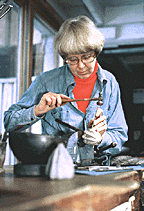
|
Until about forty years ago, the apprenticeship system was virtually the
only way of transmitting craft skills. Since that time, however, North
American learning centres have developed a new system of skill-building.
Influenced by the Bauhaus model of education, American and Canadian
colleges and universities have introduced into their curricula an
interdisciplinary programme of arts and crafts.
Thus, fine artists, craftspeople and designers are working together to
introduce students to a variety of disciplines and materials. This broader
approach, de-emphasizing early vocational specialization, has helped to
change the idea that craft is responsive only to its own aesthetic and to
marketing considerations. Instead, the acquisition of new skills and the
recovery of traditional craft techniques are encouraged within the creative
university environment.
|
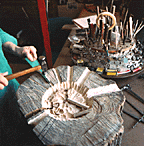
|
It was in this vibrant postwar learning environment that Lois Etherington
Betteridge was introduced to the traditional craft of silversmithing, newly
incorporated into the university curriculum. She says that silversmithing:
"was just starting in the States. Kansas University was the first
University to teach silversmithing and I was in my second year [there]. I
didn't know silversmithing existed until I went down there.... I started
taking it then, as a design student"
|
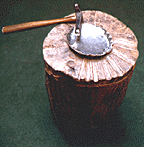
|
University silversmithing retained some of the techniques and attitudes of
the historical silversmith guilds, but no longer required apprentices to
specialize in a distinct stage or process of silversmithing. A major reason
was the influence of Scandinavian industrial design, in which the
craftsperson was responsible for all technical stages. As a result,
students were taught a wide range of skills. For example, Betteridge
learned the value of functional design in hollow-ware (or hammer-raised
silversmithing), which requires a technical mastery of tools and procedures
and a knowledge of traditional materials.
|
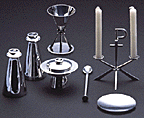
|
Private Communion Set, 1965
Sterling Silver
Raised, fabricated
Fitted wooden box by H.M. Forster,
Ruislip, Middlesex, England
20.4 cm x 20.2 cm x 20.1 cm
CMC 86-104.1 to 11
Gift of the artist
|

|

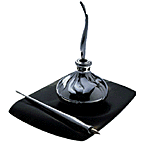
|
Script Assistant, 1977
Sterling Silver, soapstone, gold pen nib
Raised, chased, constructed, carved
Bottle: 16.9 cm x 8.2 cm diameter
Pen: 18.7 cm x 1.2 cm diameter
Stand: 18.5 cm x 14.9 cm x 2.4 cm
CMC 86-102.1 to 3 (Bronfman)
|

|
|
|
She spent the next ten years refining the many technical skills required
of her craft, experimenting with repousse, chasing, raising and the
lost-wax technique, and inlaying silver objects with ebony, horn and
precious stones. Public and private commissions challenged Betteridge to
produce secular hollow-ware and ecclesiastical silver, which she viewed as
"the ultimate compromise of making the functional object sculptural, but
not sculpture."
|

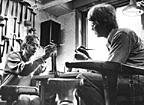 |
Lois Betteridge working with a student
at her studio in Ottawa, 1976
|

|
|
Even in this most traditional of crafts, new issues continually emerge.
The relevance of non-functional hollow-ware in contemporary silversmithing,
for example, is a topic that Betteridge debates with peers and a new
generation of silversmiths. The application of high technology in craft
manufacture and the use of synthetic materials, such as space-age ceramics
and plastics, are also provoking animated discussion. Betteridge views
these developments with some concern, fearing that traditional skills and
craftsmanship will be quickly replaced by the shortcut approach: "Don't
solder it, bolt it."
In support of her beliefs, Lois Betteridge has assumed a high profile
within the international metalsmithing community, teaching traditional
silversmithing skills to apprentices in her studio, giving lectures to
students, and participating in professional panel discussions and workshops
with her peers. Her recognized professional status demonstrates to
aspiring silversmiths that it is possible to make a career of traditional
silversmithing today.
|

